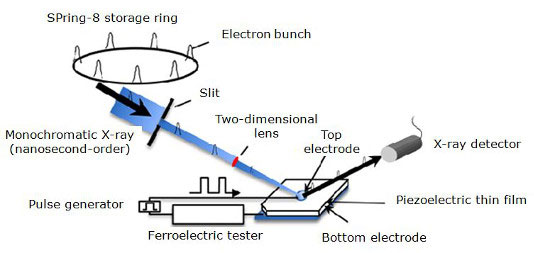| Posted: Aug 28, 2014 |
Basic properties of widely used piezoelectrics successfully measured
|
|
(Nanowerk News) A research group led by Hiroshi Funakubo, professor, Interdisciplinary Graduate School of Science and Engineering, Tokyo Institute of Technology; Osami Sakata, director, Synchrotron X-Ray Station at SPring-8,NIMS; and Tomoaki Yamada, associate professor, Graduate School of Engineering, Nagoya University (also a researcher in the Japan Science and Technology Agency PRESTO program), succeeded in fabricating a single-crystal film of lead zirconate titanate, one of the most commonly used piezoelectric materials, and directly measuring the conversion factor between electrical energy and mechanical energy ("Direct observation of intrinsic piezoelectricity of Pb(Zr,Ti)O3 by time-resolved x-ray diffraction measurement using single-crystalline films").
|
 |
| System capable of directly measuring the elongation and electrical properties of a crystal when an electric field is applied.
|
|
Taking advantage of the property of undergoing structural change when an electrical voltage is applied, piezoelectrics are used in such devices as gas stove igniters, mist-generating humidifiers, and the microelectromechanical systems (MEMS) used in inkjet and 3D printers. Because lead zirconate titanate, already in practical use, is capable of deforming its crystal structure and microstructure in a complex manner when exposed to electrical voltages signals, it has been used for the past 60 years. In spite of this fact, however, the most fundamental property of piezoelectrics, namely, the conversion factor between electrical energy and mechanical energy, had not yet been fully understood.
|
|
At SPring-8, this research group directly observed an elongated crystal lattice in a single-crystal thick film of lead zirconate titanate, which was fabricated successfully for the first time in the world, when exposed to high-speed electrical voltage pulses in the same area irradiated by high-brilliant synchrotron X-rays. As a result, the group succeeded in observing distortion of the crystal lattice that occurred within an extremely short time period: less than two 100-millionths of a second (20 nanoseconds). It also succeeded for the first time in measuring the conversion factor between electrical energy and mechanical energy of lead zirconate titanate.
|

